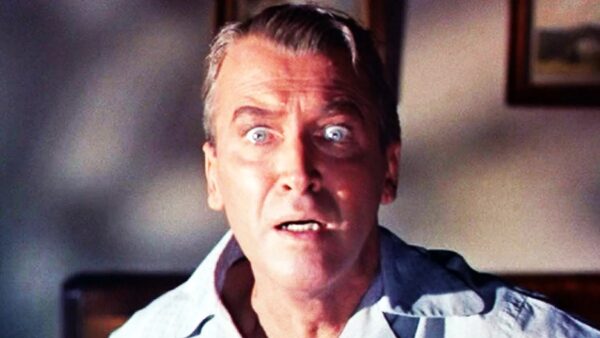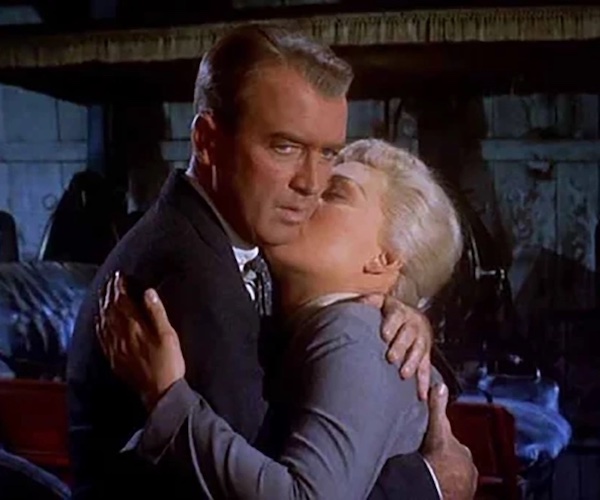Film Commentary: The Heights and Depths, the Rise and Fall, of Hitchcock’s “Vertigo”
By Peter Keough
In the end, what strikes me most about Vertigo is its melancholy, its aura of grief, its mood of inevitable, irredeemable loss.
An introduction to the Independent Film Festival of Boston screening of Vertigo, which will place on August 29 at 7:30 p.m. at the Somerville Theatre.

Jimmy Stewart waking up from a bad dream in Vertigo.
Film criticism is not a field known for its exciting controversies. True, there were the electrifying Sarris-Kael debates over Auteur theory in the 1960s. Riveting — still makes my blood boil. And then the David Manning affair in 2001, when the renowned critic for the Ridgefield Press in Danbury, Connecticut, a frequent source of glowing blurbs in movie advertisements, turned out to be a fiction, an invention of Sony studios. I am sure I am not the only critic who doubted his own existence at that time. Who knew then that existing was not even necessary when it came to having an opinion — as we know now in the age of bots and influencers?
The most recent film critic controversy of that magnitude involves tonight’s movie, Vertigo, ranked in 2012 as the best movie of all time in the Sight and Sound critics’ poll. It was was overtaken last year by Chantal Akerman’s Jeanne Dielman, 23, quai du commerce, 1080 Bruxelles (1975). Some of the objections against the choice were valid, perhaps, but others flaunted patriarchal prejudices. Such misogynist indignation might have been misplaced, however, because in some ways Vertigo, like many of Hitchcock’s films, is itself a feminist text.
That point was made by critic Laura Mulvey back in 1975 when she explained in Visual Pleasure and Narrative Cinema how Vertigo both embodied and critiqued the male gaze in cinema. That gaze, she says, is both “voyeuristic,” the pleasure that comes from watching others, and “fetishistic,” a compulsion that involves “turning the represented figure into a fetish so that it becomes reassuring rather than dangerous.” And those are the two phases of the relationship acted out in the film by Scottie Ferguson, the ex-San Francisco Police detective played by 49-year-old James Stewart, and Madeleine Elster, played by 24-year-old Kim Novak.
But the female characters in Vertigo rebel against this objectifying arrangement. Not just Madeleine, but also Midge, Scottie’s faithful college friend and former fiancée (though under what circumstances Midge, played by 35-year-old Barbara Bel Geddes in a scene-stealing performance, might have been a classmate of Scottie, presumably 14 years her senior, is a mystery). She alone of all the film’s characters genuinely loves Scottie and knows what is best for him.
So much the worse for her. In one heartbreaking scene she ironically paints a picture of herself as the object of Scottie’s obsession, only to have him fail to appreciate the joke. The laugh, sadly, is on him.

Jimmy Stewart and Kim Novak in a scene from Vertigo.
For Madeleine, though, identity is no joke. It’s a matter of life and death. Her husband has convinced Scottie to follow her. He tells Scottie that she has been possessed by the spirit of her great-grandmother, a woman driven to suicide the century before by a tyrannical patriarch. He now fears that Madeleine is doomed to the same fate. As Scottie spies on her in his role as private eye, the quintessential cinema voyeur, he falls in love — that despite, or because of, her not having a line of dialogue for the first 45 minutes of the film. Later she becomes his fetish, whom he dresses up to fulfill his image of who she is — much like Hitchcock himself did with Novak and many of his other female stars. Madeleine resists these imposed identities — with what degree of success you can judge for yourselves.
Meanwhile, we might be seeing Vertigo stirring up more controversy in the world of film criticism. Robert Downey Jr. has announced plans to produce and star in a remake of the film, claiming he can do a better job. Actually, this would not be the first remake, if you include Guy Maddin’s The Green Fog (2017), which retells the story using clips from around 200 other films and TV shows shot in San Francisco. The exercise includes perhaps the ultimate example of the male gaze in cinema: Michael Douglas in the 70s TV series The Streets of San Francisco looking at his own butt from a scene in Basic Instinct (1992) and saying, “Well, you look good, Mike. Ever thought about going into showbiz?”
In the end, what strikes me most about Vertigo is its melancholy, its aura of grief, its sense of inevitable, irredeemable loss. I find that theme epitomized in the scene where Scottie and Madeleine visit Big Basin Redwoods State Park and look at a cross section of a giant sequoia, one of many spiral images that emerge in the film (see Donald Spoto’s The Art of Alfred Hitchcock, pp. 275-77). On some of the rings are written the dates of historical events — the Declaration of Independence in 1776; the Battle of Hastings in 1066 — that occurred between the tree’s felling in 1930 and its first sprouting in the 10th century.
“Here I was born,” Madeleine says, pointing to a ring. “There I died. You took no notice.”
Novak, now 90, is still with us. The tree section, though, is no more, consumed in a wildfire in 2020.
Peter Keough writes about film and other topics and has contributed to numerous publications. He had been the film editor of the Boston Phoenix from 1989 to its demise in 2013 and has edited three books on film, most recently For Kids of All Ages: The National Society of Film Critics on Children’s Movies (Rowman & Littlefield, 2019).

Superb essay. Without doubt behind the male gaze, Vertigo is a proto-feminist telling – both women can love, the man cannot. I didn’t know the tree ring was consumed by fire – now part of the continuing story.Thank you for this excellent assessment.
I would add that Vertigo is as much about radical vulnerability — male and female — as it is melancholy. Scottie is beset with psychological and physical limitations. Male strength in the film takes the form of guile (Madeline’s scheming husband) or insensitive authority figures who often demean the ‘weaker’ Scottie. Madeline admits that she becomes part of Scottie’s mania out of weakness — as well as love. She fakes a psychological breakdown. Ironically, Madeline’s death is triggered by her seeing a “vision.” Is it any wonder that the film did not do well? It is an unyielding study in fragility — a very rare thing in American cinema, which usually glorifies strength.
More superb insights. At the end Scottie is “cured” of his vertigo, ie recovers his strength, but can we possibly think he is anything other than irredeemably broken now? Whatever illusions of strength we grasp on to, we are terminally fragile. The last words spoken: “God have mercy.”
And he may be cured but he has a lot of explaining to do to the police. Fool me once…
A vision of a nun who “heard voices” no less. And did Scottie ever make it off that ladder at the beginning?
Thanks for so many additional insights, Peter — I’d become obsessed with “obsession” and color theory re: Vertigo and needed to be pulled out of those “ruts” for at least the time being ~~~ re: this truly best film of all time.
Now, in 2023, I’d love to see Vertigo on a double-bill with Barbie, so we can knock the latter down at least just a few rungs; my head is still hurting from being messaged to oblivion about themes that Vertigo handles with so much more depth.
Concise insights–we get a summary of the film criticism from the past 70 years and a recapitulation of what makes “Vertigo” a masterpiece. I agree with Bill Marx about vulnerability. Hitchcock creates a canvas of weakness, obsession, and pain. The nun has the last word–a warning to beware passion and be abstemious? Hitchcock was a Catholic…
Yes! Have the Barbie-arians seen any other films? It reminds me of the La La Land adulation. Fans gushed over a musical for people who hate musicals. The “La La Land “Oscar” was the ultimate Hollywood Freudian slip.
Sorry, Tom: I like musicals though rarely love them, but I adore The Umbrellas of Cherbourg and its American counterpart, La La Land. I also liked Barbie though didn’t love it, and, as you know, I’ve seen several thousand films.
Chacun à son goût; I sense a pattern here!